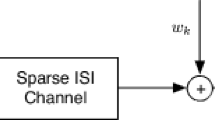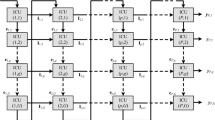Abstract
In this work, a novel block-wise Kaczmarz successive interference cancellation (BKSIC) detector, that is, a generalization of the Kaczmarz SIC detector proposed recently, is presented. Two reduced complexity versions of this detector are also detailed. This new detector is then analyzed using a matrix algebraic approach and shown that it is in fact a matrix filtering of the received signal, which allows the derivation of a closed form expression for its BER performance. Its convergence behavior is studied and the conditions of its convergence are determined. Simulation results indicate that the proposed block-wise SIC detector not only reduces significantly the detection delay but also achieves better BER performance.










Similar content being viewed by others
Notes
A flop stands for floating point operation. Operations such as addition, multiplication, subtraction, division, and compare are considered one flop.
References
Adnan S, Yuli F, Ahmed BJ, Tahir MF, Banoori F, (2020) Modified ordered successive interference cancellation MIMO detection using low complexity constellation search, AEU – Int J Electron Commun 121.
Ahmad M, Baig S, Asif HM, Raahemifar K (2021) Mitigation of imperfect successive interference cancellation and wavelet-based nonorthogonal multiple access in the 5G multiuser downlink network. Wirel Commun Mob Comput 2021(8876026):11. https://doi.org/10.1155/2021/8876026
Albreem MA, Juntti M and Shahabuddin S, (2019) Massive MIMO detection techniques: a survey, in IEEE Communications Surveys & Tutorials, vol. 21, no. 4, pp. 3109-3132, Fourthquarter
Babich F, Comisso M, Cuttin A et al (2020) Exploiting capture and interference cancellation for uplink random multiple access in 5G millimeter-wave networks. Ann Telecommun 75:1–15. https://doi.org/10.1007/s12243-019-00714-w
Bentrcia A, (2008) Linear Interference Cancellation Structures in DS-CDMA Systems, D.Sc, Dissertation, Batna University, Algeria
Bentrcia A (2019) Kaczmarz successive interference cancellation: a matrix algebraic approach. Digit Signal Process 89:60–69
Bentrcia A, Alshebeili SA (2012) Regularization property of linear interference cancellation detectors. EURASIP J Adv Signal Process 2012:1–17
Bentrcia A, Zerguine A (2009) A new linear group-wise parallel interference cancellation detector. Wirel Pers Commun 49:23–34. https://doi.org/10.1007/s11277-008-9553-7
Chen M and Burr A, (2019) Multiuser detection for uplink non-orthogonal multiple access system, in IET Communications, 13, 19 pp. 3222-3228, 3 12. https://doi.org/10.1049/iet-com.2018.6092.
Choi J (2010) MIMO detection with successive interference cancellation. In: Optimal combining and detection: statistical signal processing for communications. Cambridge University Press, Cambridge, pp 217–245. https://doi.org/10.1017/CBO9781139193535.009
Debi Pada J, Gupta S, (2020) Machine learning enabled detection for OOK-PD-NOMA system over standard single mode fiber. Optics Commun 473
Elfving T, Hansen PC, Nikazad T (2016) Convergence analysis for column-action methods in image reconstruction. Numer Algorithm 74(3):905–924. https://doi.org/10.1007/s11075-016-0232-6
Guo W, Chen H (2012) Improving SIRT algorithm for computerized tomographic image reconstruction. In: Qian Z, Cao L, Su W, Wang T, Yang H (eds) Recent advances in computer science and information engineering. Lecture Notes in Electrical Engineering, vol 128. Springer, Berlin, Heidelberg.
Johansson AL, Rasmussen LK, (1998) Linear group-wise successive interference cancellation in CDMA, in: IEEE 5th International Symposium on Spread Spectrum Techniques and Applications. Proceedings, vol. 1, 2–4, pp.121–126.
Kilzi A, Farah J, Abdel Nour C and Douillard C, (2020) Mutual successive interference cancellation strategies in NOMA for enhancing the spectral efficiency of CoMP systems, In IEEE Transactions on Communications, vol. 68, no. 2, pp. 1213-1226.
Liang Y, Islim MS, Haas H. (2017) LiFi: transforming fibre into wireless, Proc. SPIE 10128, Broadband Access Communication Technologies XI, 1012802
Miridakis NI and Vergados DD, (2013) A survey on the successive interference cancellation performance for single-antenna and multiple-antenna OFDM systems, in IEEE Communications Surveys & Tutorials, vol. 15, no. 1, pp. 312-335, First Quarter. https://doi.org/10.1109/SURV.2012.030512.00103.
Nguyen TK, Nguyen HH and Nguyen TH, (2019) Multiuser massive MIMO systems with time-offset pilots and successive interference cancellation, in IEEE Access, vol. 7, pp. 132748-132762, doi: https://doi.org/10.1109/ACCESS.2019.2940458.
Ohashi AA et al., (2021) Cell-free massive MIMO-NOMA systems with imperfect SIC and non-reciprocal channels, in IEEE Wireless Communications Letters, vol. 10, no. 6, pp. 1329-1333, doi: https://doi.org/10.1109/LWC.2021.3066042.
Peköz B, Ankarali ZE, Köse S and Arslan H, (2020) Non-redundant OFDM receiver windowing for 5G frames and beyond, in IEEE Transactions on Vehicular Technology vol. 69, no. 1 pp. 676-684.
Rasmussen LK, Lim TJ and Johansson A, (2000) A matrix-algebraic approach to successive interference cancellation in CDMA, in IEEE Transactions on Communications, vol. 48, no. 1, pp. 145-151, .
Tran T, Voznak M (2020) On secure system performance over SISO, MISO and MIMO-NOMA wireless networks equipped a multiple antenna based on TAS protocol. J Wireless Com Netw 2020:11. https://doi.org/10.1186/s13638-019-1586-y
Verdu S (1998) Multiuser Detection. Cambridge University Press
Acknowledgements
The author acknowledges the support of King Saud University.
Author information
Authors and Affiliations
Corresponding author
Additional information
Publisher’s note
Springer Nature remains neutral with regard to jurisdictional claims in published maps and institutional affiliations.
Rights and permissions
About this article
Cite this article
Bentrcia, A. Block-wise Kaczmarz successive interference cancellation: a matrix algebraic approach. Ann. Telecommun. 77, 589–599 (2022). https://doi.org/10.1007/s12243-021-00883-7
Received:
Accepted:
Published:
Issue Date:
DOI: https://doi.org/10.1007/s12243-021-00883-7




